Following the American Revolution, each state attempted to set up a customs service of its own. However; by 1789 it was apparent that a more consisent and coordinated Federal service was necessary. On 31 July of that year, President Washington signed legislation which established the United States Customs Service. As a branch of the Treasury Department, it became the first fully-formed national agency, and was created primarily to generate much-needed revenue for the new government.
Initially there were 59 customs districts set up in 11 states. Each district employed a customs collector, appointed by the President, and a naval officer. Other officials assisted the collector at the various ports within each district. The larger ports like New York and Boston would employ various numbers of surveyors, weighers, gaugers, inspectors, and revenue-cutter crews, all with specific responsibilities for the conduct of business at the port.
The Customs Service was originally responsible for the collection of duties on imported goods, the registering and licensing of American vessels, the enforcement of all maritime and navigation laws, and the management of regulations governing the entry and clearance of seamen and passengers. While these functions remained, responsibilities were expanded and became more specialized during the nineteenth century. After 1793, regulatory forms for exports as well as imports were required. Between 1798 and 1809, the customs enforced the various embargo and non-intercourse laws, issued regulatory documentation, and initiated libel action against violators. The Marine Hospital, providing care for sick or disabled seamen, was founded in 1798, and the customs officials were delegated to collect hospital fees from vessels arriving at their port. After 1819, customs districts were required to collect the passenger lists of all vessels arriving from foreign ports. Other responsibilities included holding imported goods in bonded warehouses until the duty was paid (1846); keeping official records on the sale of vessels (1850); and regulating steamship commerce and safety.
By 1860, the increasing complexity of regulating maritime commerce had made the customs service a large agency, responsible for nearly one half of the revenue taken in by the Federal government.
What follows is a representative selection of customs forms and certificates issued by port officials, and/or recorded by them as part of their daily activities. Along with related items like bonds, oaths, and receipts, found elsewhere in this book, they can provide the reader with a better understanding of what the customs service did during this period, and just what documents were required for the lawful conduct of maritime business.
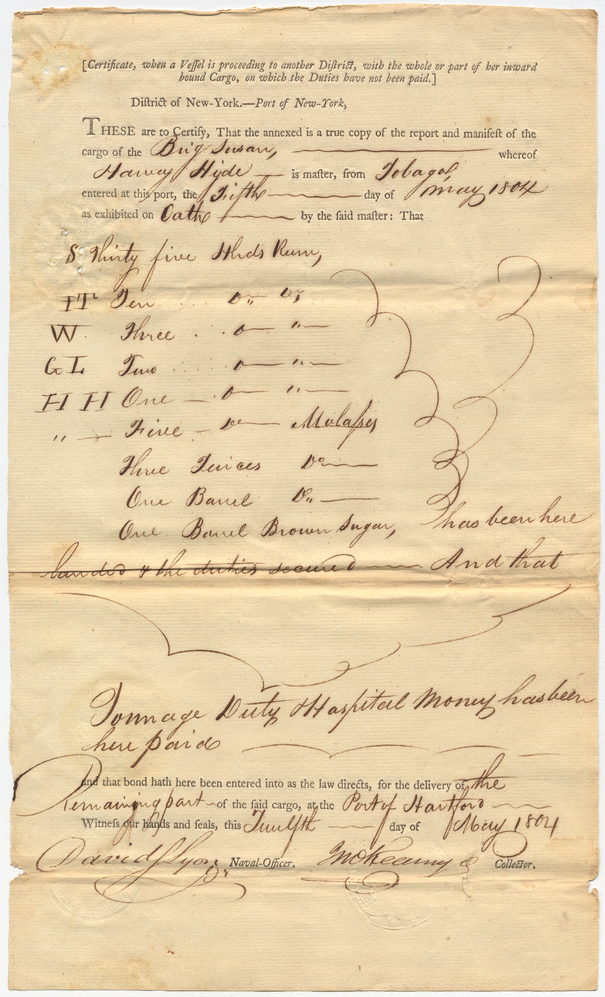
Certificate For a Vessel Going to Another District with Inward Bound Cargo on which Duties have not been paid. This is an example of the many kinds of documents used during this period by the customs districts to control the movement of imported goods within the United States, for the purpose of securing all appropriate duties before they entered the private market. In this example the brig Susan landed and paid duty on the cargo described at New York. The Certificate, issued through the collector there of his cargo to Hartford.
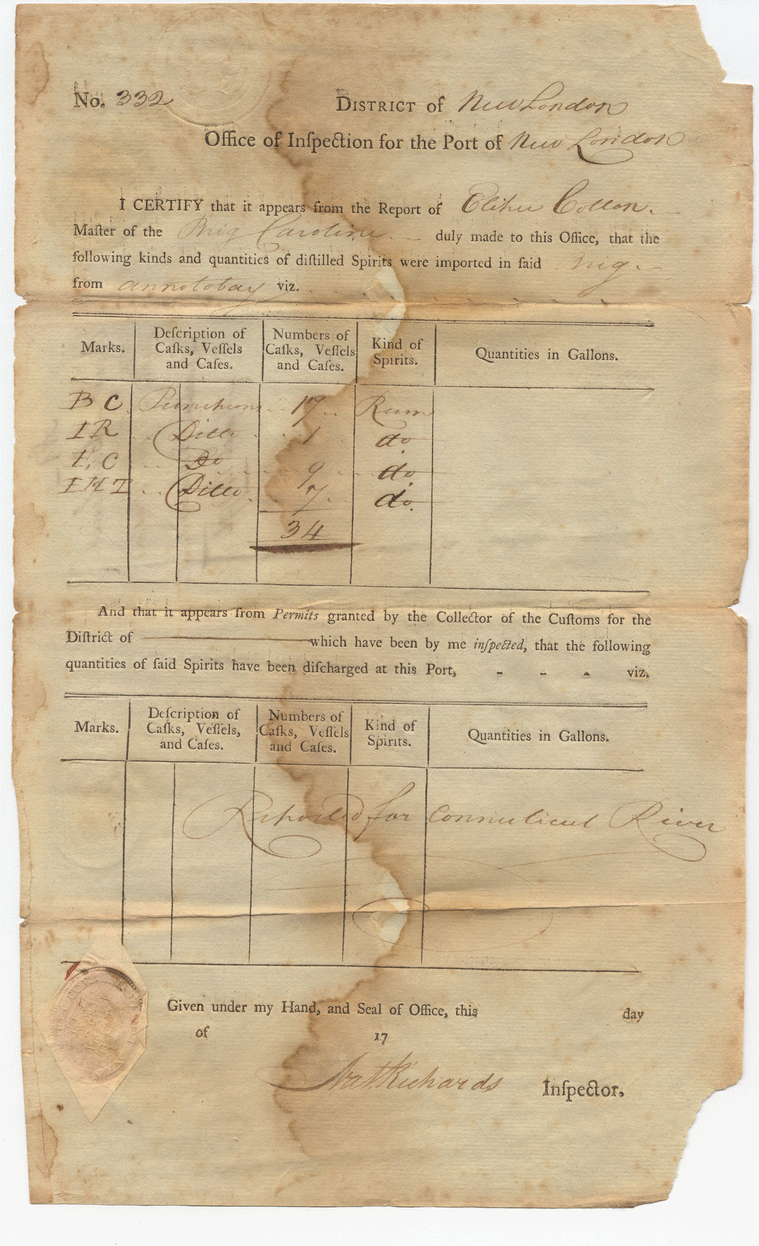
Certificate of Importation and Discharge: The movement and control of imported spirits, rum, wine, etc., provided an important source of revenue for the new American government. This Certificate, signed by a Inspector at the Port of New London, indicates that 34 puncheons of rum had arrived aboard the brig Caroline, but was to be discharged later at a destination along the Connecticut River in 1796.
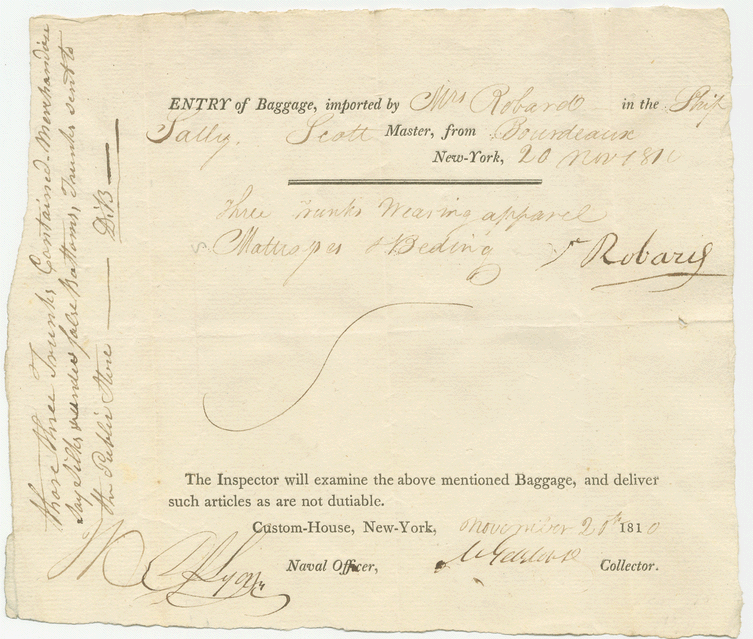
Entry of Baggage Permit: Personal baggage was inspected for dutiable articles. This document, signed by the collector, authorized the inspector to examine the baggage of a Mrs. Robard, arriving from France in November 1810. In this case a marginal notation indicates that the three trunks contained false bottoms which hid dutiable goods.
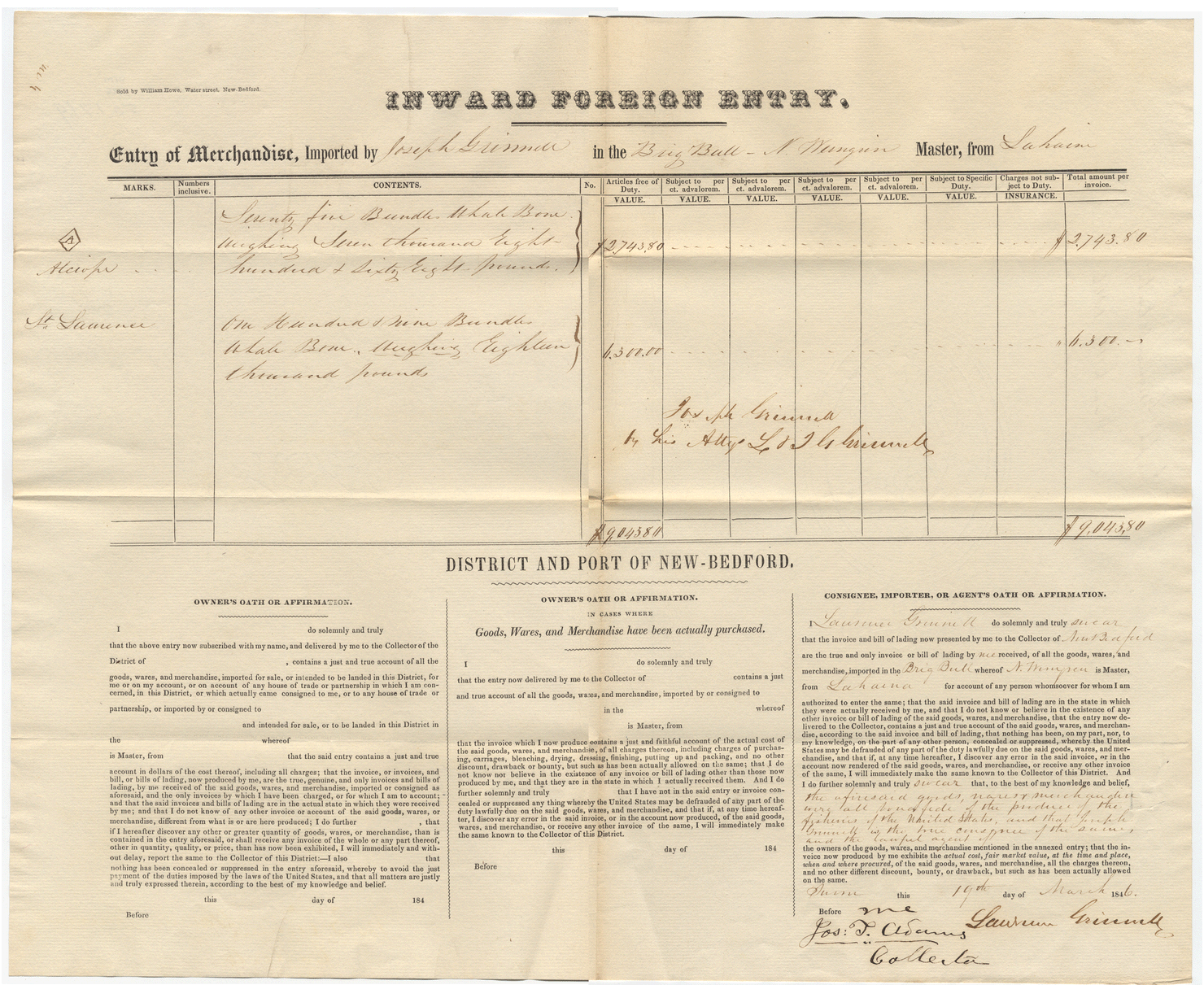
Inward Foreign Entry Certificate: This customs document, in various forms, was issued through the collector whenever imported foreign cargo arrived in his district. It contains a description of the goods, and in addition required an oath from the owner, agent, or consignee, that the items were legally imported, that the manifest was accurate, and that the appropriate duties had been paid. Once the Certificate was completed to the collector’s satisfaction, he signed it and the goods were released from the port’s authority.
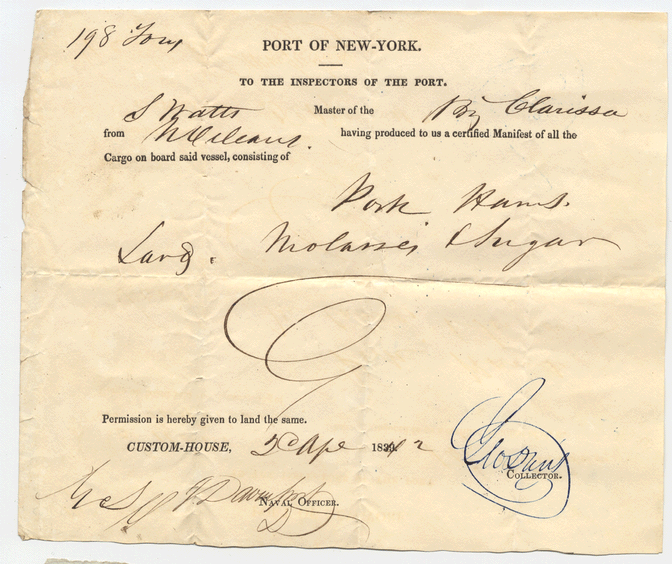
Permit to Land Cargo: This customs document, varying in size and form, was almost always signed by the collector and naval officer, and then given to the shipmaster. It indicated that the ship’s papers were in order and that, in the case of foreign goods, all relevant duties had been paid. After presenting the Permit to the inspector, the shipmaster could then unload his cargo.
Permit of Leave Quarantine Ground: A custom’s document, issued by the port’s Health Officer, indicating that the vessel has complied with the quarantine regulations and that everyone aboard has been pronounced in good health. The vessel was then able to enter port, discharge passengers and cargo, and conduct ship’s business. However, in the permit illustrated here, the schooner La Grange, from New Orleans, spent six days in quarantine before being cleared only “to proceed through the Sound,” but not come ashore in New York, subject to a $2,000 fine.

Certificate of Deposit in the Public Store: Illegal goods, or items on which duties had not been paid, were discharged from the vessel and put into a warehouse, often called the Public Store. They remained there under the supervision of a customs (i.e.the store keeper) until such time as the duties were paid by the consignee, or perhaps sold at public auctions for the benefit of the government. The receipt illustrated here reveals that a large shipment of flour had been sized and deposited in the Public Store by the inspector.
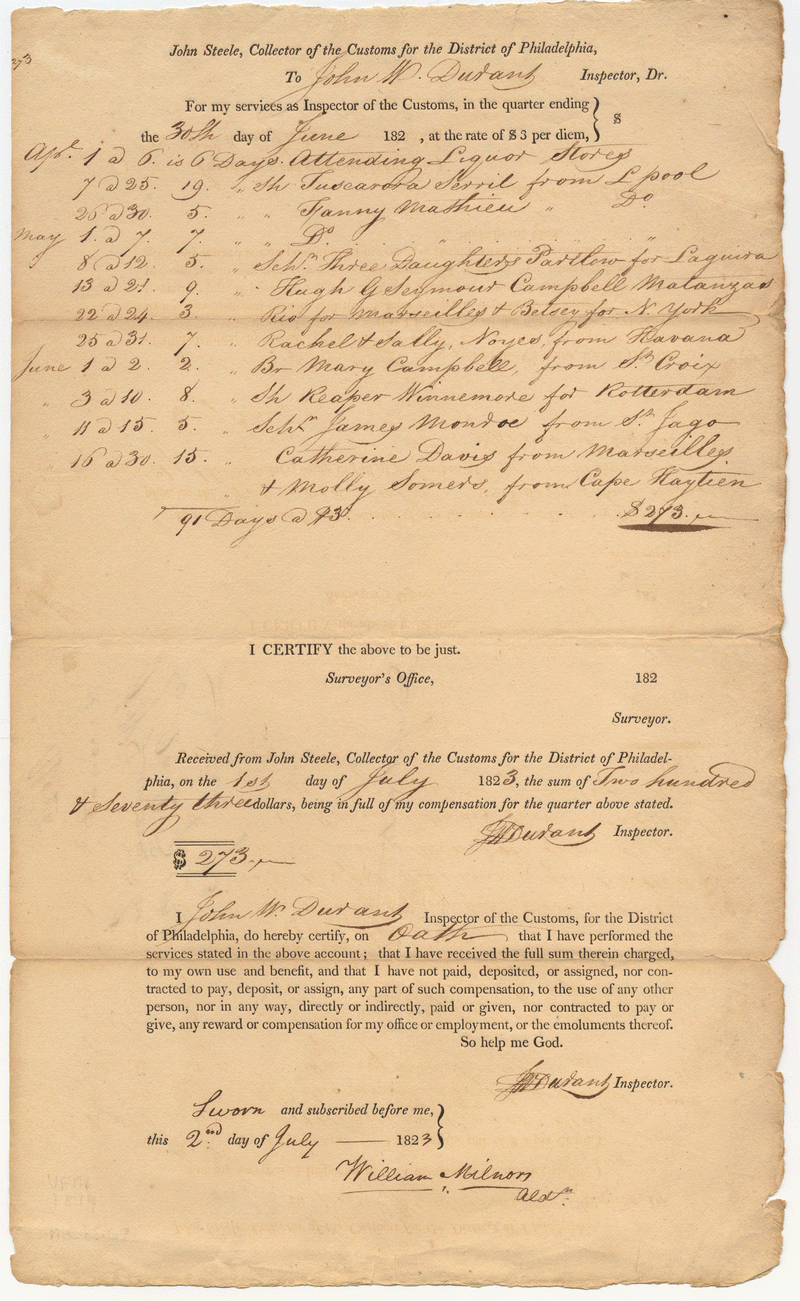
Inspector’s Statement & Receipt: Customs document providing a quarterly statement of services and a receipt for wages, relative to John Durant, an Inspector of the Customs in Philadelphia, 1823. Although not often found in maritime collections, such documents can provide valuable information about the duties and wages of customs employees, as well as insight into the organizational structure of the customs operation at the particular port.
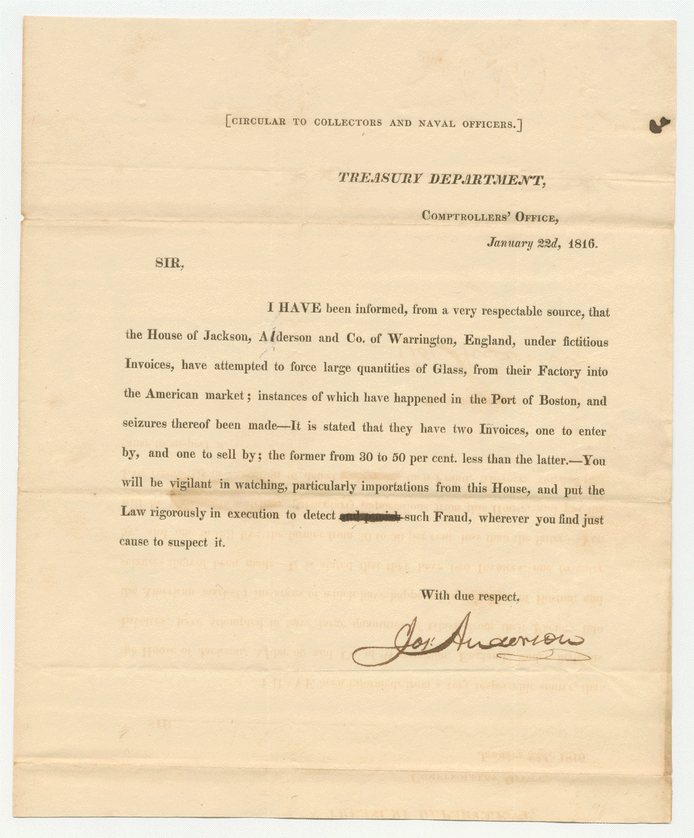
Treasury Department Circulars: These Circulars (i.e., printed letters or announcements), were issued by the Treasury Department and sent out to the collectors at ports throughout the nation. It was the primary method used to keep each district abreast of the latest legislation and conditions affecting customs administration. Circulars often contain the signature of the Secretary of the Treasury.
